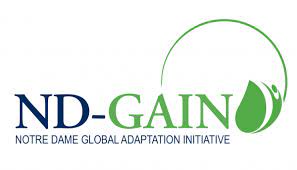Notre Dame Global Adaptation Initiative (ND-GAIN) Index

A recent analysis, based on Notre Dame Global Adaptation Initiative (ND-GAIN) index, has shown the impact of climate change on children across the world.
- The analysis was done by Save the Children International, a child rights non-profit organization.
Notre Dame Global Adaptation Initiative:
- ND-GAIN is part of the Climate Change Adaptation Program of the University of Notre Dame’s Environmental Change Initiative (ND-ECI).
- ND-GAIN’s Country Index shows which countries are best prepared to deal with global changes brought about by overcrowding, resource constraints, and climate disruption.
- The Country Index uses 20 years of data to rank more than 180 countries annually based on their vulnerability and, uniquely, how ready they are to adapt.
- According to the scores for 2018, India ranked 122 and is the 48th most vulnerable country and the 70th least-ready country.
Key Points:
- Sub-Saharan Africa has 35 of the 45 countries globally at the highest climate risk.
- Climate risk can be defined as a combination of hazard exposure, sensitivity to impact, and adaptive capacity.
- Chad, Somalia, the Central African Republic, Eritrea, and the Democratic Republic of the Congo are the least capable of adapting to the impact of climate change.
- Around 490 million children under the age of 18 in 35 African countries are at the highest risk of suffering the impact of climate change.
- Of the 750 million children in 45 countries likely to be most affected by climate risk, 210 million are in three South Asian nations Pakistan, Bangladesh, and Afghanistan.
Impact of Climate Change on Children:
- Floods, droughts, hurricanes, and other extreme weather events will have a deep impact on vulnerable children and their families.
- Malaria and dengue fever already plague children in the Democratic Republic of Congo.
- Increasing extreme weather events can lead to new health risks while the health system is already limited.
- Around 9.8 million people were displaced due to the disasters caused by climate change during the first half of 2020.
- Most of them were in South and South-East Asia and the Horn of Africa confirmed the World Meteorological Organisation in its flagship State of the Global Climate report.
- Children will be impacted by food shortages, diseases, and other health threats, water scarcity, or be at risk from rising water levels – or a combination of these factors.
- There is enough evidence that establishes the impact of the “climate crisis on food production”. Hence, this will lead to local food scarcity and price hikes.
- Climate change can disrupt food availability, reduce access to food, and affect food quality.
- Children of the poorest households will be the most affected.
- In fact, there has been scientific evidence of the link between obesity, under-nutrition, and climate change.




